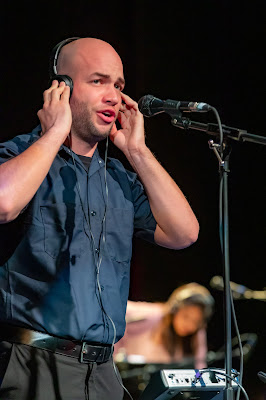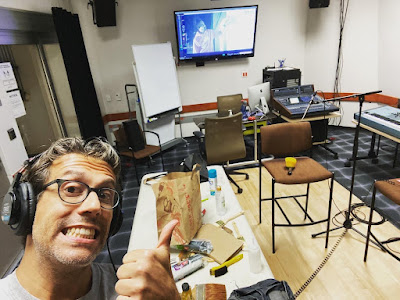I was going to start this blog post by talking about the impacts on UCI Sound by COVID-19, but there’s nothing new under the sun there. It stinks, and we all know it. So let’s skip ahead.
In November 2021, UCI Sound was an integral part of the first live in-person mainstage performance at UCI since the pandemic began. AUDIO THEATER was a bill of six student-written plays, performed live and recorded for eventual streaming (stay tuned!). The plays were performed as part of a single bill, and each performance was recorded. At the end of the run, the designers and directors chose the strongest performance, and the sound design team then prepared the recordings for streaming.
 |
| photo by Paul Kennedy |
For UCI Sound, this was a complex task. Six plays, each with their own sonic landscape, each with their own cast. Six playwrights, each with their own text, some of which were in more flux than others. Six directors, each with their own vision, who were serving both the audience live in the theater and the eventual streaming audience. Five designers (four sound, one lighting – no scenic, costumes, or projections), who needed to serve their plays and support each other. A phalanx of stage managers, who kept rehearsals efficient, safe, and effective. Dozens of actors, plenty of staff and support personnel. One sound system, with one production assistant and one A1 (our two first-year MFAs).
For pandemic reasons, we mounted these productions with actors spaced out, at microphones, in static positions. They could look at each other and communicate over distance, but they couldn’t leave their microphone position. This gave the event more of a broadcast feeling rather than a theatrical feeling.
 |
| photo by Paul Kennedy |
Each console input and output was recorded for maximum flexibility when mixing/producing after the run. Once the designers had finished mixing their pieces, they passed their final mixes off to one student who served as the mastering engineer for the whole bill.
Each of the designers has written a bit about their play and their approach to the sound design for it. So, here they are in their own words (edited slightly):
DO YOU TRUST ME? – JJ Margolis, Sound Designer
Do You Trust Me, written by Summer Savonna Session and directed by Cybelle Kaehler, is a nostalgic flashback story set in the late 90’s. After meeting in middle school, Leon and his best friend Ty develope a tradition of exploring haunted buildings in their town. In high school, they take their girlfriends to a warehouse prepared with alien-themed props, traps, and sound effects to scare Jess, and in that warehouse they encounter… something they do not expect.
The task of sound for this story was to help support the world and ground the vocal performance in a believable, but not wholly realistic space. Through the combination of recorded audio effects and synthesized sounds, the ‘scenery’ of the play is established. One of the most interesting challenges of this is the balancing act of building a supernatural suspense without confirming in one way or another whether there is truly anything unnatural present.
As the core of the play, the vocals stood central at all times. I used different reverb effects to bring the characters into the spaces that they flashed back to. In addition, I needed to separate Leon into both a narrator and a character. I accomplished this by isolating the lines that he spoke as narrator, keeping them clean of any aforementioned reverb and adding a tube-modeled compressor to support the warmth of those lines. Finally, I layered very subtle processing onto some of the characters as the story progressed… but that would be spoilers.
LIE IN STATE – Aerik Harbert, Sound Designer
As we round out a year since the January 6th insurrection in the Capitol, Lie In State, written by Meliza Gutierrez and directed by Angela Cruz, serves as a testimonial to the events of that day. Not of reality, but of possibility; it’s impossible to know the exact complexities of what it meant to be a police officer, congressperson, or innocent bystander on location that day, but Lie In State gives us a taste of their fear, hope, and humanity. When confronting the possibility of death first hand, who knows what may come to mind?
Many of us have seen video taken on location, but there is an inherent safety in a recording because we know that we were not personally the targets of that mob. I needed to keep the feeling of danger up so that our characters never felt truly at ease, while still leaving space for them to speak their piece. There are discrete events supported by sound as protesters break into the building which highlight specific moments of danger, but the true danger in this setting is the human element, so I chose to use a persistent bed of protesters which always lived in the background.
This background detail ebbs and flows dynamically to carve space for important moments of dialogue for the actors, and it only peaks at specific moments where the increase in danger was necessary to keep stakes up as we moved from dramatic beat to dramatic beat. There are some non-diegetic elements, but overall, the sound lived within the world of the play so that the characters and audience are engaged in the same level of energy.
WHEN WILL MI HIJA VISIT ME? – Meghan Roche, Sound Designer
When Will Mi Hija Visit Me? written by Cindy El & directed by Leah Jackson, focuses in on a mother telling her friend the story of her daughter’s disappearance from her life. Maria is our main (and only speaking) character, and we wanted to keep her “real world” and “memory world” as separate as possible so there would be moments where the audience felt firmly in the world of Maria’s literally telling this story to her psychological space as she recounted it; that became my main focus as I designed the piece.
To achieve the “real world” moments, I used room tone and other low sound effects, like distant outdoor ambiance and a ticking clock, to place us in her kitchen. We also had live foley accompanying the very first and very last moments of the piece as Maria makes her coffee and fiddles with her spoon and mug. This took a fair amount of trial and error; we made good use of UCI’s extensive prop shop to find the right materials to make the sounds we wanted, and I auditioned a lot of different options for room tone—the ones I’d been working with initially wound up feeling much more out of place in the physical space than they did when I was making mock-ups and pulling SFX on my computer at home! But eventually we found a good balance, and the room tones in combination with EQ and reverb processing felt quite convincing in the Claire Trevor Theater.
The “memory world” also made use of EQ and reverb, but were meant to feel significantly less grounded than the kitchen FX did, and all of the SFX I used in the more involved flashback sequences also had a fair amount of that same reverb. There was also subtle tonal underscoring in a number of places to help support the most emotional moments.
The in-person presentation of this piece was a little different than what you will hear in the recording, as it also involved two non-speaking actors onstage doing movement work as Maria’s husband and daughter, silently acting out the story as she told it in a stylized and very physical manner. Because we do not get that in the recording, a few spots were trimmed down and adjusted to make the pauses in our actor’s speech make more sense.
The Happiest Bunch – Costa Daros, Sound Designer
The Happiest Bunch, written by Mary Hill and directed by Mary Hill and Arizsia Staton, was a slice-of-life comedy break in our night of dramas. I wanted to embrace the endearing sitcom style, so the design was mostly realistic with some exaggerated moments to heighten the comedy like Martha's murmuring and our moment within their phone conversation. Overall, the sound helped to bring the piece to life and give the characters something to react to during their performance.
Nearer By Far – Meghan Roche, Sound Designer
Nearer By Far, written by Erica Clare Bogan and directed by Dylan Seeley, was another one-actor play. It takes place in a submersible unit—essentially a very tiny submarine designed to go deep in the ocean—and is told in the form of the taped journal entries recorded by one-half of an underwater duo who were there doing undisclosed scientific research. Early in the piece, however, we learn that the other half of the team was killed, and our main character has to figure out what went wrong, and how to survive on her own.
From the beginning of our discussions about this piece, we knew that we wanted to lean into the “found tape” aspect of it, using vocal processing to really compress & affect our actor’s vocals in a way that emulated the feeling of listening to an old recording & adding in sound effects that were very specific to starting and stopping a tape recording. This came less from a desire for realism, but instead as a way to heighten drama and show the passage of time between journal entries. I also made heavy use of various drone styles—more easily heard in-person, with our beefy subwoofers and lovely Meyer speakers, than on the average computer speakers, but still present nonetheless—for the drama piece of things. They shifted subtly from entry to entry, but all throughout there was also a separate drone that faded up very slowly and imperceptibly as it went, which made the dropout of almost all of our atmospheric sounds at a power outage moment late in the piece all the more emotionally affecting.
The Informant – Costa Daros, Sound Designer
The Informant, written by Grace McCarney and directed by Lucas Nelson, was the retelling of a woman's involvement in WWII to her granddaughter. As she narrates the story, the characters she talks about come to life and take over the dialogue for her. I designed the sound in order to help divide these worlds of the story being narrated by her future-self from the story taking place in real time. This gave us the opportunity to incorporate live foley into the design which helped the characters around the woman create the world she talked about.
Right now, we’re putting the finishing touches on the mixes and mastering them. Once the elements are in the can, we’ll be streaming them over the nets! I’ll post again then.






